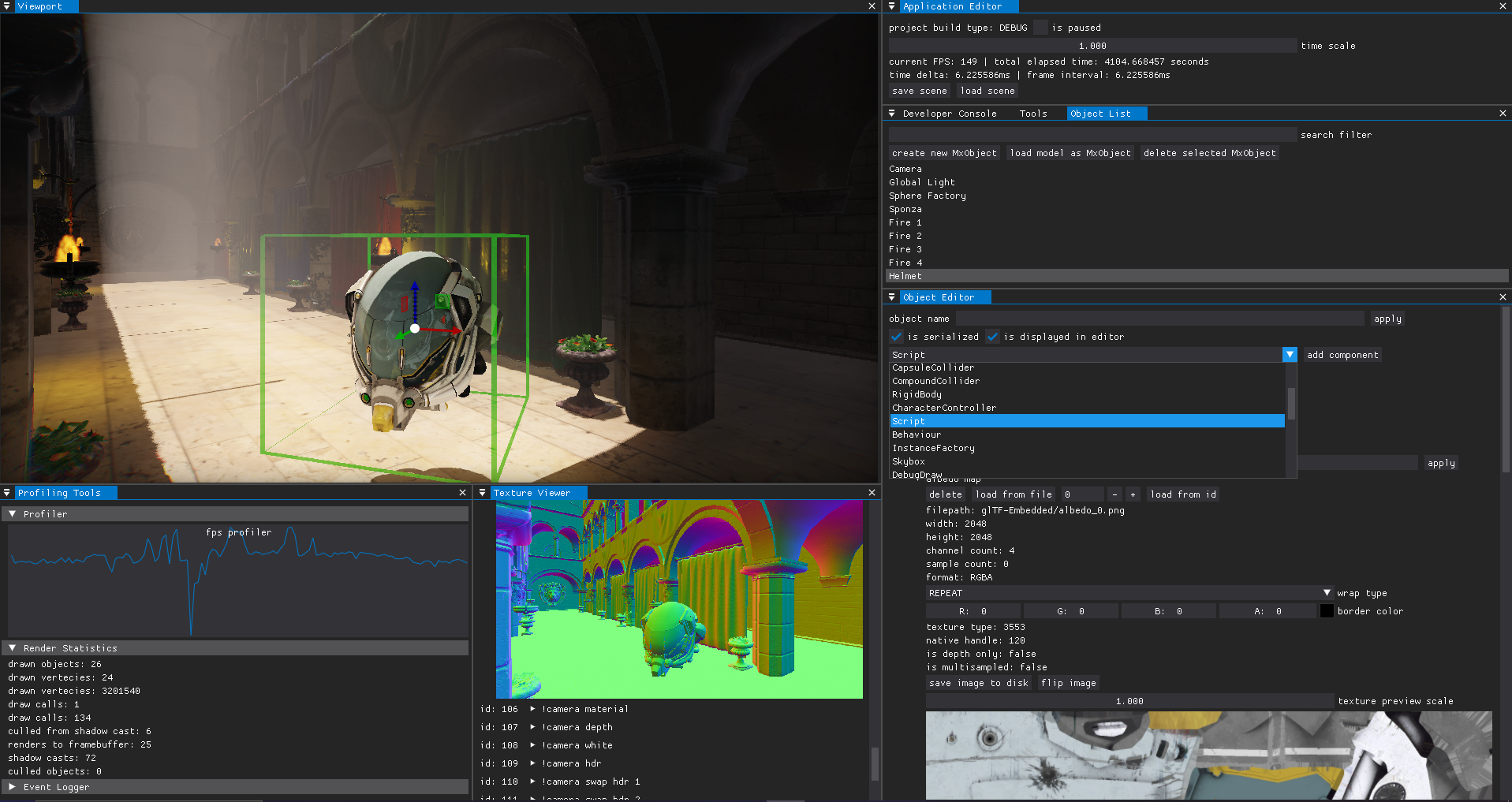asc-community / Mxengine
Programming Languages
Projects that are alternatives of or similar to Mxengine
MxEngine
MxEngine is an educational modern-C++ general-purpose 3D game engine. Right now MxEngine is developed only by me, #Momo, but any contributions are welcome and will be reviewed. Fow now MxEngine supports OpenGL as graphic API and targeting x64 only. My plans include other graphic API support, but do not expect it in the near future, as there are still a lot of other stuff to do.
Versions & Releases
MxEngine releases come with versions in format X.Y.Z where X stands for major release, Y for minor release and Z for bug fixes or non-significant changes.
Major releases are prone to breakage of already existing API and functional but bring a lot new features to the engine. Usually it is possible to rewrite all code using new API and retain former behaviour.
Minor releases may change API or add new features but usually user code can be easily adapted to them. With this releases also come some new MxEngine user libraries (for example new bindings or non-required components)
Bug fixes & improvements are just fixes to already existing code to reestablish initially planned behaviour. This fixes may also be merged into major or minor releases if they come in the same time.
For full version list see versions.md file
Installing and running MxEngine
As a developer (if you want to contribute or check samples)
Right now MxEngine is distributed in source code with configurable CMake files. Here are the steps you need to do to compile and run MxEngine sample projects:
- clone this repo to your system using
git clone https://github.com/asc-community/MxEngine - initialize submodules with
cd MxEngine && git submodule update --init - build project by running
CMakeLists.txtlocated in root directory (set up necessary options if needed) - select one of sample executables and run it to check if everything was built successfully
- to create your own project, consider taking ProjectTemplate sample as starting point, it has everything already configured for build
As a user (if you want to develop your own application)
To develop your own applications using MxEngine you can use template project with already setup dependencies: MxEngineTemplate (make sure it contains up-to-date version of the engine)
Feature list
Rendering features
- Physically Based Rendering (Cook-Torrance GGX)
- Screen Space Reflection, Screen Space Ambient Occlusion, Screen Space Global Illumination
- Cascade shadow maps, omnidirectional shadow maps, spot projection maps
- directional, point and spot dynamic lights
- Adaptive tone mapping, FXAA, fog, bloom effect
- 2D debug utilities: light, sound, object bounds, lines, rectangles and etc.
Physics features
- Rigid body dynamics: static, dynamic and kinematic bodies
- Collision detection with triggers and callbacks
- Raycasting with object type filtering
Audio features
- 3D sounds with distance attenuation
- Support of popular audio formats: .mp3, .ogg, .wav, .flac
Programmable API
- Entity Component System (20+ different components)
- Safe to use handle system (RAII or by managable object pools)
- 50+ supported objects formats via Assimp library (with automatic normal & tangent generation)
- Event system with ability to add your own event types
- Logging, image & cubemap loading, json reading, UUID, random generators and more
Scripting & runtime editing
- Runtime C++ code compilation via dynamically load libraries
- Runtime GLSL shader editing (both engines and your own)
- ImGui editor with multiple draggable windows (docking)
- Load/save file dialog, texture viewer, mesh, material & component editors
- One-click scene loading/saving, generic serializer for all components and resources
Code snippets
Primitive creation
You can easily create spheres, planes, cylinders and etc. Custom number of vertecies for displacement maps are supported out of box
auto cube = MxObject::Create();
cube->AddComponent<MeshSource>(Primitives::CreateCube());
cube->AddComponent<MeshRenderer>();
Loading object from file
MxEngine is using Assimp library which can load any popular object format. To load materials simply pass same path to object file
auto object = MxObject::Create();
object->AddComponent<MeshSource>(AssetManager::LoadMesh("objects/your_object.obj"));
object->AddComponent<MeshRenderer>(AssetManager::LoadMaterials("objects/your_object.obj"));
Creating lights
Dynamic directional lights, spot lights and point lights are supported. Each has simular interface and is created in a uniform way
auto object = MxObject::Create();
auto light = object->AddComponent<SpotLight>();
light->SetColor(Vector3(1.0f, 0.7f, 0.0f));
light->SetIntensity(100.0f);
light->SetAmbientIntensity(0.3f);
light->SetOuterAngle(45.0f);
Using scripts for runtime code compilation
by creating a seperate file with special macro definition you are able to add scripts to objects and then edit them in runtime - the scripts will be recompiled automatically:
#include <MxEngine.h>
using namespace MxEngine
class YourScript : public Scriptable
{
public:
virtual void OnCreate(MxObject& self) override { }
virtual void OnReload(MxObject& self) override { }
virtual void OnUpdate(MxObject& self) override { }
};
MXENGINE_RUNTIME_EDITOR(YourScript);
// you can add it as a component by name:
auto object = MxObject::Create();
object->AddComponent<Script>("YourScript");
Creating multiple objects using GPU instancing
you can create MxObjects which share same mesh and material. They all can have different position and color, but still rendered in one draw call
auto factory = object->AddComponent<InstanceFactory>();
auto instance1 = factory->Instanciate();
instance1->Transform.SetPosition({0.0f, 1.0f, 0.0f});
auto instance2 = factory->Instanciate();
instance2->Transform.SetPosition({0.0f, 2.0f, 0.0f});
auto instance3 = factory->Instanciate();
instance3->Transform.SetPosition({0.0f, 3.0f, 0.0f});
Playing audio files
To play audio files in 3D world, attach listener to player object and create object with audio source component. mp3, wav, flac and ogg file formats are supported
auto player = MxObject::Create();
auto listener = player->AddComponent<AudioListener>();
auto object = MxObject::Create();
object->Transform.SetPosition({1.0f, 0.0f, 1.0f});
auto audio = object->AddComponent<AudioSource>(AssetManager::LoadAudio("sounds/music.mp3"));
audio->Play();
Managing multiple cameras
You can create cameras and render scene from different angles. The results can be used for post-effects or dynamic textures
auto object = MxObject::Create();
auto camera = object->AddComponent<CameraController>();
camera->SetDirection(Vector3(1.0f, 0.0f, 0.0f));
Creating physical objects
MxEngine supports realtime physics simulation. Just add RigidBody component and attach suitable collider
auto sphere = MxObject::Create();
sphere->AddComponent<MeshSource>(Primitives::CreateSphere());
sphere->AddComponent<MeshRenderer>();
sphere->AddComponent<SphereCollider>();
auto rigidBody = sphere->AddComponent<RigidBody>();
rigidBody->SetMass(1.0f);
rigidBody->SetLinearVelocity({0.0f, 10.0f, 0.0f});
Raycasting on your game scene
All physical objects with colliders can be raycasted and accessed using simple api
auto raySource = Vector3(0.0f);
auto rayDirection = Vector3(1.0f, 0.0f, 0.0f);
auto rayLength = 100.0f;
auto rayDistance = raySource + rayDirection * rayLength;
float rayFraction = 0.0f;
auto object = Physics::RayCast(raySource, rayDistance, rayFraction);
if(object.IsValid())
{
MXLOG_INFO("raycast", "found object: " + object->Name);
MXLOG_INFO("raycast", "distance to object: " + ToMxString(rayLength * rayFraction));
}
Setting up timers and events
You can sign up for event or create timer with specific call interval in one line of code
Timer::CallEachDelta([]() { MXLOG_INFO("MyTimer", "I am called every 500ms!"); }, 0.5f);
Event::AddEventListener("MyEvent", [](UpdateEvent& e) { MXLOG_INFO("MyEvent", "I am called every frame!"); });
Reading input from user devices
To read input, you can add event listener or just retrieve state in update method. Also, there are binders for player controls
auto player = MxObject::Create();
auto control = player->AddComponent<InputController>();
control->BindMovement(KeyCode::W, KeyCode::A, KeyCode::S, KeyCode::D);
if (Input::IsMousePressed(MouseButton::LEFT))
ShootBullet(player);
Integrating your editors into MxEngine runtime editor
If you want custom editors in your application, you can use ImGui functions in update loop
void OnUpdate() override
{
if(Runtime::IsEditorActive())
{
ImGui::Begin("MySettings");
ImGui::InputFloat("player health", &health);
ImGui::InputFloat("player ammo", &ammo);
ImGui::End();
}
}
Saving rendered images to disk
Sometimes you want to save rendered image to your hard drive. There are functions to do so
auto texture = cameraController->GetRenderTexture();
ImageManager::SaveTexture("images/camera.png", texture);
ImageManager::TakeScreenShot("images/viewport.png");
Drawing debug primitives
There are cases when you just want to display some 2D primitives to debug your game or check current object state
auto debug = object->AddComponent<DebugDraw>();
debug->RenderBoundingBox = true;
debug->BoundingBoxColor = Colors::Create(Colors::RED);
Rendering::Draw(Line({0.0f, 0.0f, 0.0f}, {10.0f, 10.0f, 10.0f}), Colors::Create(Colors::GREEN, 1.0f));
Scene managing
You can save your game objects, resources and scripts into a json script file. They can be loaded later with one function
// application state and all MxObjects and resources are saved and written to a json file
Scene::Save("scene.json");
// to completely replace current scene with another simply load a json file
Scene::Load("another_scene.json");
Dependencies
If you are interesed in libraries MxEngine depend on, consider reading dependencies.md file. It contains third-party library list with links to each project's github repository and brief explanation of why each library is used in the engine. Note that some of the libraries are shipped in modified version, so do no try to edit engine CMake file if your are unsure if everything will still work correctly
Answers to some questions:
- Is it possible to build MxEngine under Linux/MacOS/other system?
MxEngine supports Windows/Linux builds. Unluckly, other systems are not supported out-of-box for now. If you want to help with porting library to other systems, consider reading PR guideline.
- Whats the roadmap for the engine? Which features can I expect to see, if I follow this repository?
I put all features and not-fixed bugs to the public trello board. If you want to see some specific feature in engine, which is not mentioned already, you can request it in feature request issue
- Why do you do this project? How long are you planning to develop the engine? Will it one day be better than UE/Unity/Godot?
Initially this was an educational project (actually I still learn a lot of new things when developing it), where I learned about OpenGL, graphics, software engeneering and game development. I loved it and still love to spend my free time fixing some stuff or implementing new features. Thats really a great opportunity to have such cool project, even if it will never be any better than existing game engines like Unity or Unreal Engine
- If I want to help you with development, how can I get into this project? Is there a documentation for it?
Sadly there are too much things that I need to document and so much features which I need to implement, that I have almost no time for proper documentation. You can start with
ProjectTemplateCMake project, and try some things for yourself. I promise I will add more samples with each release to make usage of the engine easier. If you want to help me with developing, building on other systems or fixing bugs, first contact me personally (links to my social media can be found in my profile). We can discuss what you may do and how can you help the engine to progress
More engine screenshots
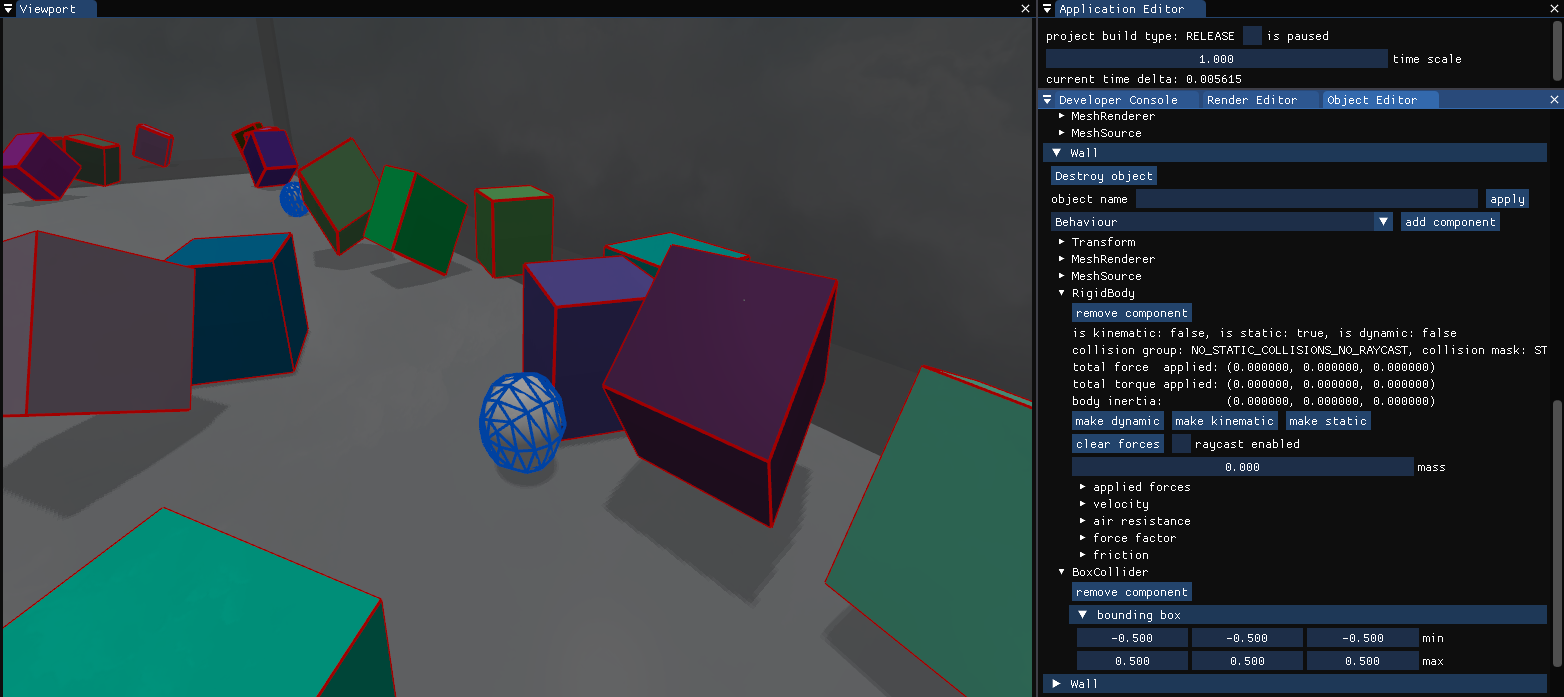 physics simulation with colliders turned on
physics simulation with colliders turned on
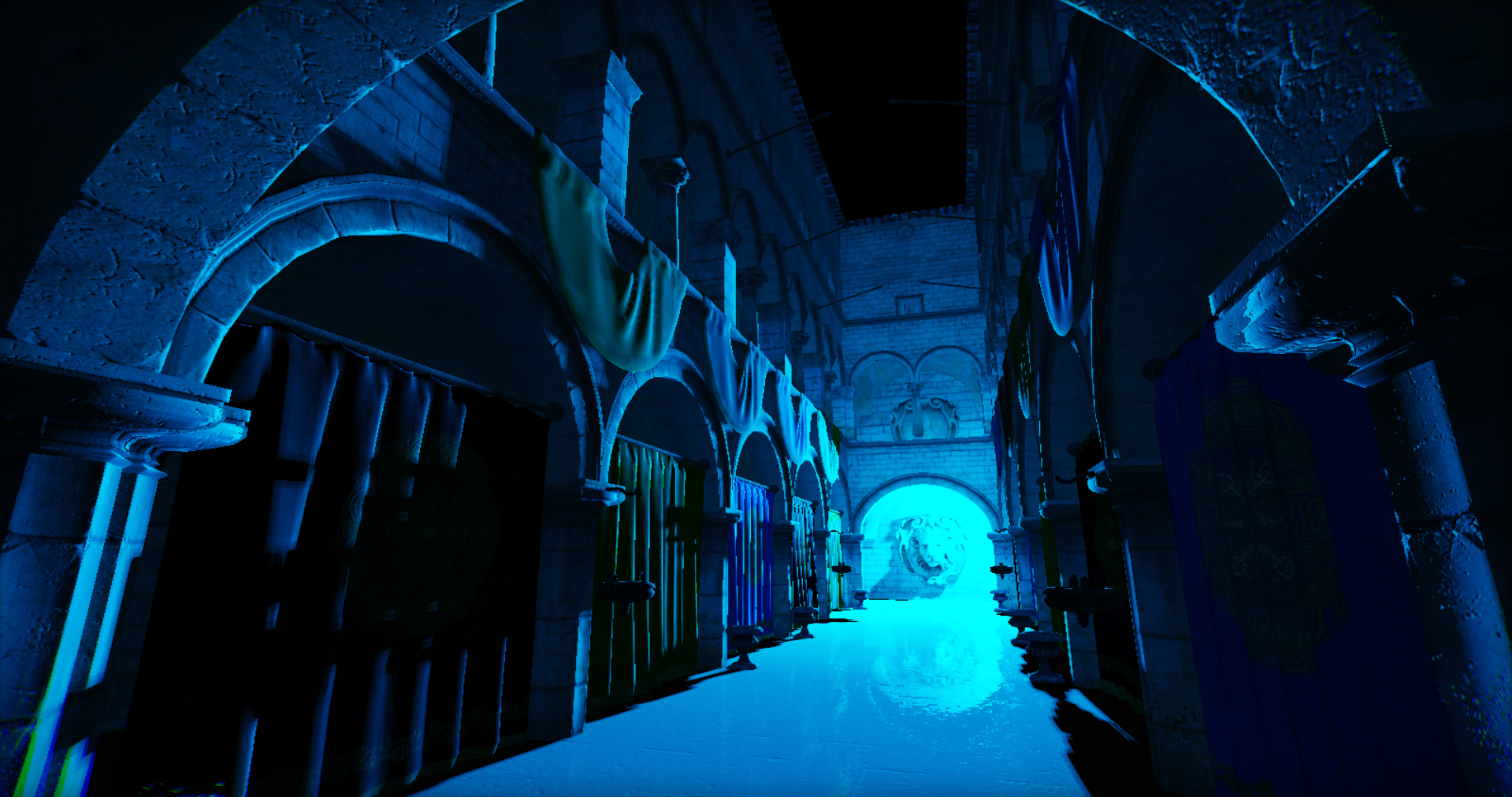 Sponza scene with one point light
Sponza scene with one point light
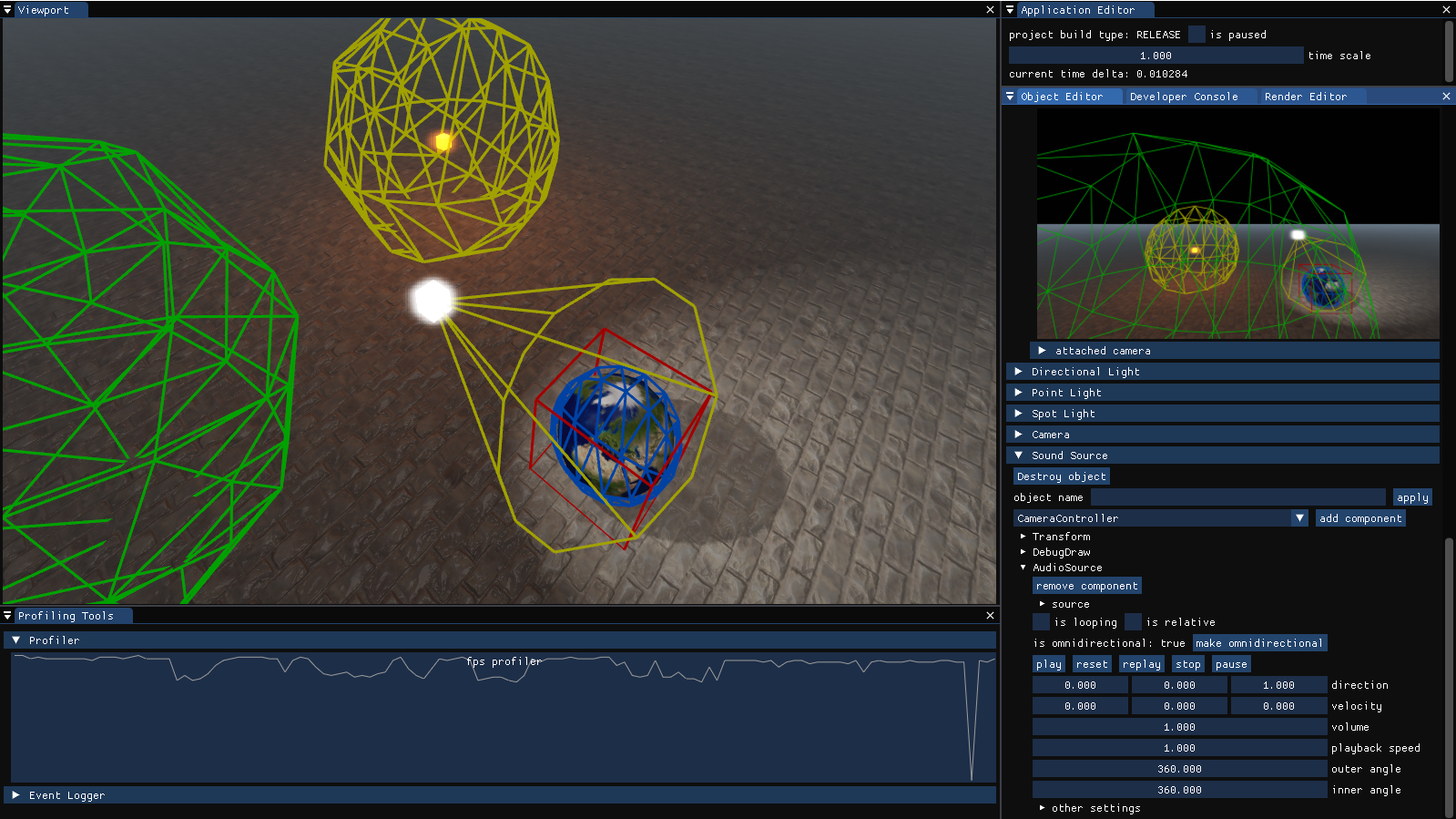 light and sound bounds, other debug utilities
light and sound bounds, other debug utilities
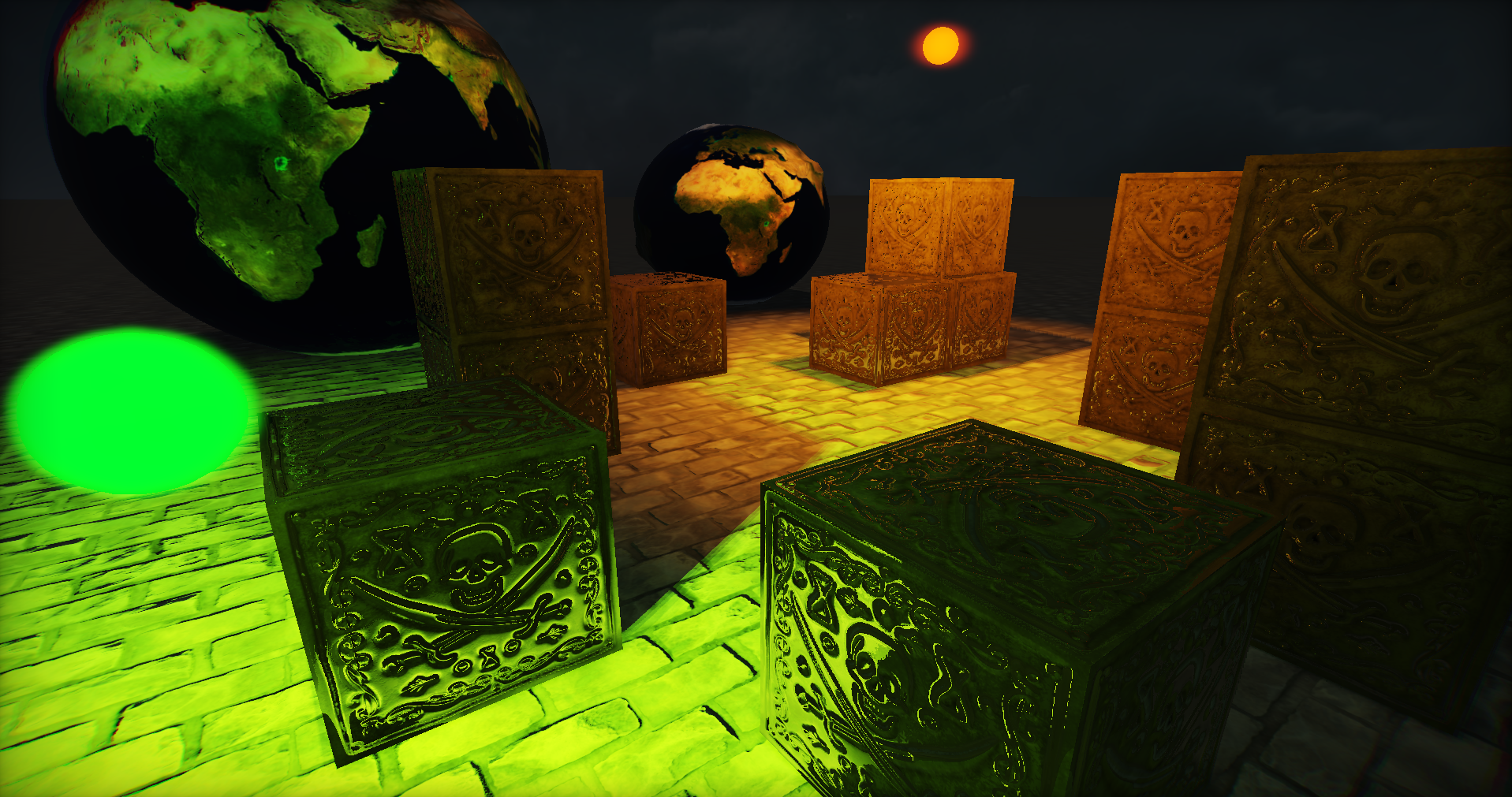 shadow casting from dynamic lights, screen-space reflections
shadow casting from dynamic lights, screen-space reflections
Projects based on MxEngine
Here is the list of some projects using MxEngine. If you want to see yours here, contact me.
PathTracer by MomoDeve
Path tracing in GLSL shaders, project link: https://github.com/MomoDeve/PathTracer
Rainball by WhiteBlackGoose
3D pseudo water simulation, project link: https://github.com/WhiteBlackGoose/Rainball






